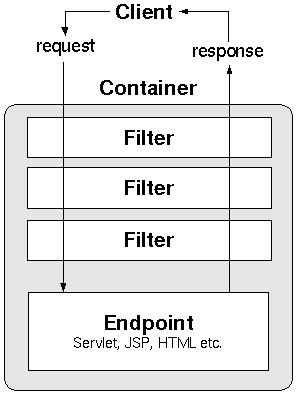说句实话,JCL(Jakarta Commons Logging)和log4j真把我搞蒙了。不都是做log的吗,怎么在jcl的源码包中,还有个log4j的包?倒底谁跟谁啊?至到看了jcl的用户指南,才明白一些。hehe.
1、Commons-Loggin简介
Jakarta Commons Logging (JCL)提供的是一个日志(Log)接口(interface),同时兼顾轻量级和不依赖于具体的日志实现工具。 它提供给中间件/日志工具开发者一个简单的日志操作抽象,允许程序开发人员使用不同的具体日志实现工具。用户被假定已熟悉某种日志实现工具的更高级别的细节。JCL提供的接口,对其它一些日志工具,包括Log4J, Avalon LogKit, and JDK 1.4等,进行了简单的包装,此接口更接近于Log4J和LogKit的实现.
2、快速入门
1、Commons-Loggin简介
Jakarta Commons Logging (JCL)提供的是一个日志(Log)接口(interface),同时兼顾轻量级和不依赖于具体的日志实现工具。 它提供给中间件/日志工具开发者一个简单的日志操作抽象,允许程序开发人员使用不同的具体日志实现工具。用户被假定已熟悉某种日志实现工具的更高级别的细节。JCL提供的接口,对其它一些日志工具,包括Log4J, Avalon LogKit, and JDK 1.4等,进行了简单的包装,此接口更接近于Log4J和LogKit的实现.
2、快速入门
《每一个WEB应用程序,都应该有两个过滤器》by Jayson Falkner
原文如下:
Almost every single web application you will ever make will seriously benefit from using servlet filters to both cache and compress content. A caching filter optimizes the time it takes to send back a response from your web server, and a compression filter optimizes the size of the content that you send from your web server to a user via the Internet. Since generating content and sending content over the World Wide Web are the bread and butter of web applications, it should be no surprise that simple components that aid in these processes are incredibly useful. This article details the process of building and using a caching filter and a compression filter that are suitable for use with just about any web application. After reading this article, you will understand caching and compressing, have code to do both, and be able to apply caching and compression to any of your future (or existing!) web applications.
Review: Servlet Filters in 10 Sentences
Servlet filters are powerful tools that are available to web application developers using the Servlet 2.3 specification or above. Filters are designed to be able to manipulate a request or response (or both) that is sent to a web application, yet provide this functionality in a method that won't affect servlets and JSPs being used by the web application unless that is the desired effect. A good way to think of servlet filters is as a chain of steps that a request and response must go through before reaching a servlet, JSP, or static resource such as an HTML page in a web application. Figure 1 shows the commonly used illustration of this concept.

原文如下:
Almost every single web application you will ever make will seriously benefit from using servlet filters to both cache and compress content. A caching filter optimizes the time it takes to send back a response from your web server, and a compression filter optimizes the size of the content that you send from your web server to a user via the Internet. Since generating content and sending content over the World Wide Web are the bread and butter of web applications, it should be no surprise that simple components that aid in these processes are incredibly useful. This article details the process of building and using a caching filter and a compression filter that are suitable for use with just about any web application. After reading this article, you will understand caching and compressing, have code to do both, and be able to apply caching and compression to any of your future (or existing!) web applications.
Review: Servlet Filters in 10 Sentences
Servlet filters are powerful tools that are available to web application developers using the Servlet 2.3 specification or above. Filters are designed to be able to manipulate a request or response (or both) that is sent to a web application, yet provide this functionality in a method that won't affect servlets and JSPs being used by the web application unless that is the desired effect. A good way to think of servlet filters is as a chain of steps that a request and response must go through before reaching a servlet, JSP, or static resource such as an HTML page in a web application. Figure 1 shows the commonly used illustration of this concept.

现在越来越多的网站应用都加入RSS或是ATOM这一类新功能,用户可以通过它更准确的订阅到自己想知道的信息,去掉大量的陈旧信息和无用的广告,信息比以往任何时候都要来得及时。而作为公司来说,统一的接口会使市场更加的规范,使得个人用户的选择更多,我们可以利用RSS来轻松的从一个BLOG搬家到另一个BLOG。这也让我们看到了,WEB2.0这一理念越来越被广泛应用。
由于开源产业的不规范性,出现了RSS与ATOM两类格式的XML文本。虽然newsfeed这种新型的新闻供应机制存在种种质疑,但newsfeed的潜力是有目共睹,势不可挡。不管在将来谁会取代谁,作为我们程序员来说也应尽快尽可能全面的了解此类新技术。而国内JSP方面对于此技术的关注实在少得可怜。资料也甚是难找。
下面本站将介绍用JAVA如何来生成RSS&ATOM.XML
这里我们用到了SUN公司开发的ROME.jar做这一系列事情。
先制作一个接口类及其抽象方法
由于开源产业的不规范性,出现了RSS与ATOM两类格式的XML文本。虽然newsfeed这种新型的新闻供应机制存在种种质疑,但newsfeed的潜力是有目共睹,势不可挡。不管在将来谁会取代谁,作为我们程序员来说也应尽快尽可能全面的了解此类新技术。而国内JSP方面对于此技术的关注实在少得可怜。资料也甚是难找。
下面本站将介绍用JAVA如何来生成RSS&ATOM.XML
这里我们用到了SUN公司开发的ROME.jar做这一系列事情。
先制作一个接口类及其抽象方法
复制内容到剪贴板 程序代码
程序代码
 程序代码
程序代码import java.util.Collection;
import java.util.Date;
import java.util.Date;
JDOM是一种使用 XML 的独特 Java 工具包,用于快速开发 XML 应用程序。它的设计包含 Java 语言的语法乃至语义。
JDOM是两位著名的 Java 开发人员兼作者,Brett Mclaughlin 和 Jason Hunter 的创作成果, 2000 年初在类似于 Apache 协议的许可下,JDOM 作为一个开放源代码项目正式开始研发,JDOM 作为一个开放源代码项目正式开始了。它已成长为包含来自广泛的 Java 开发人员的投稿、集中反馈及错误修复的系统,并致力于建立一个完整的基于 Java 平台的解决方案,通过 Java 代码来访问、操作并输出 XML 数据。
虽然许多Java 开发人员每天都在使用 XML,Sun 却在将 XML 整合进 Java 平台方面落后了。因为在 XML 成为从商家对商家集成到 Web 站点内容流水化等方面的关键技术之前,Java 2 平台就已经非常流行了。Sun 已经使用 JSR 过程使之成为现存 XML API 的鼻祖,这一点已被广泛接受。目前最显著的是加入了 JAXP (用于 XML 语法分析的 Java API),其中包含了三个软件包:
·org.w3c.dom ,W3C 推荐的用于 XML 标准规划文档对象模型的 Java 工具
·org.xml.sax ,用于对 XML 进行语法分析的事件驱动的简单 API
·javax.xml.parsers ,工厂化工具,允许应用程序开发人员获得并配置特殊的语法分析器工具 JDOM 能够替换 org.w3c.dom 软件包来有计划地操作 XML 文档
JDOM是两位著名的 Java 开发人员兼作者,Brett Mclaughlin 和 Jason Hunter 的创作成果, 2000 年初在类似于 Apache 协议的许可下,JDOM 作为一个开放源代码项目正式开始研发,JDOM 作为一个开放源代码项目正式开始了。它已成长为包含来自广泛的 Java 开发人员的投稿、集中反馈及错误修复的系统,并致力于建立一个完整的基于 Java 平台的解决方案,通过 Java 代码来访问、操作并输出 XML 数据。
虽然许多Java 开发人员每天都在使用 XML,Sun 却在将 XML 整合进 Java 平台方面落后了。因为在 XML 成为从商家对商家集成到 Web 站点内容流水化等方面的关键技术之前,Java 2 平台就已经非常流行了。Sun 已经使用 JSR 过程使之成为现存 XML API 的鼻祖,这一点已被广泛接受。目前最显著的是加入了 JAXP (用于 XML 语法分析的 Java API),其中包含了三个软件包:
·org.w3c.dom ,W3C 推荐的用于 XML 标准规划文档对象模型的 Java 工具
·org.xml.sax ,用于对 XML 进行语法分析的事件驱动的简单 API
·javax.xml.parsers ,工厂化工具,允许应用程序开发人员获得并配置特殊的语法分析器工具 JDOM 能够替换 org.w3c.dom 软件包来有计划地操作 XML 文档
Tags: JDom

